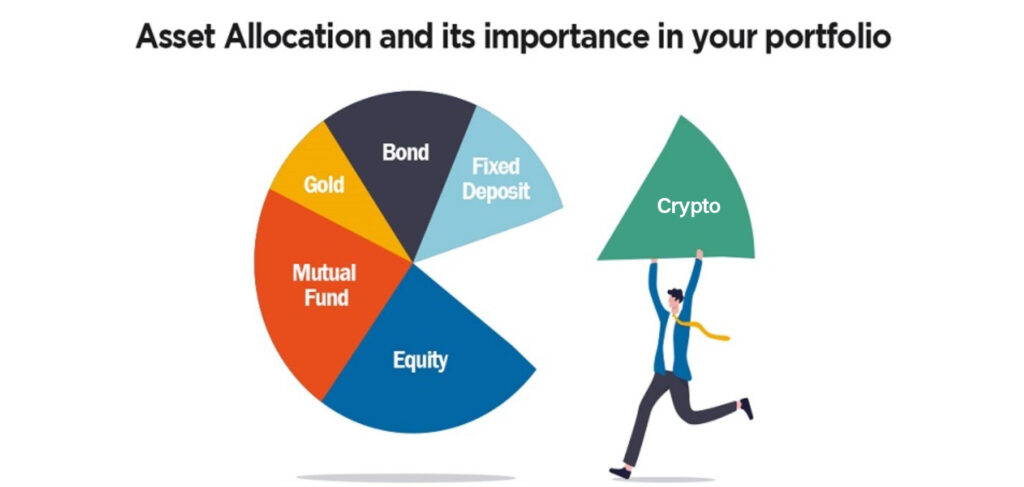A person’s Investment Portfolio comprises the assets they possess, encompassing stocks, bonds, and cryptocurrencies. Engaging in investments can serve as an effective means to amass wealth in the extended run, yet initiating this process might seem daunting, particularly when confronted with newer investment avenues such as cryptocurrencies.
Establishing an individual investment portfolio stands as a pivotal stride in realizing financial objectives, necessitating meticulous planning and contemplation of several factors. Let’s delve deeper into some critical factors entailed in constructing a personal investment portfolio.

Assessing Risk Tolerance in Investment Portfolio Planning
Risk tolerance pertains to an investor’s capacity and willingness to endure financial losses. For novices, this involves considering factors such as their end objectives, their present financial standing, and their grasp of investment vehicles, among other elements.
▪️ Setting Objectives: The initial stage an investor might embark upon to gauge their risk tolerance involves outlining their financial objectives. For instance, common long-term financial aspirations could encompass saving for retirement or amassing wealth for future generations, while short-term aims may involve buying a car or pursuing higher education soon.
These objectives can significantly impact risk management and tolerance because they might determine an investor’s time horizon—the duration they intend to retain their assets before liquidating them.
A more extended time horizon might prompt an investor to assume greater risk, as long-term profits could offset short-term market fluctuations. Conversely, entering the market with shorter time horizons, like planning to purchase a house within two years, may mean that enduring immediate price changes could significantly impede this objective.
▪️ Present Financial Position & Commitments: Having a comprehensive understanding of existing financial commitments can assist in determining the amount investors can invest without jeopardizing their ability to meet bills, debts, and essential expenses.
For instance, an individual with a steady income and an emergency fund capable of covering unforeseen medical expenses, job loss, or home repairs might be more open to riskier investments, such as cryptocurrencies. Typically, the recommended emergency fund is sufficient to cover an individual’s financial obligations for the estimated duration it might take to secure a new job within their industry.
Conversely, someone lacking savings for emergencies might need to contemplate a more cash-heavy investment mix to prevent having to sell high-risk assets in the event of an unforeseen setback, potentially resulting in a loss.
▪️ Understanding Various Asset Classes During Investments: Another aspect investors might need to factor in when determining risk tolerance is their familiarity and experience with the assets they plan to include in their portfolio, especially when dealing with cryptocurrencies.
For example, if they possess a sound understanding of the crypto market and how crypto wallets operate, they might feel more at ease handling the risks associated with such investments.
However, individuals new to cryptocurrencies might consider starting with a smaller investment and gradually increasing their holdings as they gain more confidence in navigating the market and its inherent volatility.
Strategizing the Allocation of Assets for a Well-Balanced Investment Portfolio
The process of asset allocation involves distributing investments across various asset classes like stocks, bonds, cash, and alternative investments such as cryptocurrencies. Achieving the right equilibrium can give investors an advantage in pursuing their objectives.

Typically, a conservative investor might opt for a higher proportion of bonds and cash in their portfolio, whereas an investor with a longer investment horizon might favor a greater allocation towards individual stocks and crypto assets. It’s crucial to understand that asset allocation is not a singular decision and may require adjustments as investment goals and risk tolerance evolve.
For example, an investor with substantial cash reserves might allocate 70% of their funds to stocks, 20% to bonds, and 10% to cash. While assigning 70% to stocks could be seen as risky, if this investor can cover unforeseen expenses using the 10% cash reserve, they might feel at ease with taking this risk.
On the other hand, someone nearing retirement might prefer a higher allocation of bonds and cash, reserving a smaller portion for stocks and cryptocurrencies. If their cash reserves adequately cover retirement expenses, they might consider holding a fraction of their funds in riskier assets.
Ways to Broaden Your Investment Portfolio
Diversifying your investments can help mitigate downturns in specific stocks and cryptocurrencies. To reduce the risk stemming from heavy investments in a single region or sector, investors can spread their assets across diverse classes, sectors, and global regions.
Investors have the option to diversify through mutual funds or exchange-traded funds (ETFs). However, it’s crucial to note that diversification doesn’t assure profits or safeguard against losses during market declines. While a prudent strategy, it doesn’t eliminate risk entirely.
Mutual funds and Crypto ETFs might suit investors seeking a hands-off diversification approach, as these are curated by reputable financial institutions. Examples like the S&P 500 and FTSE 100 exemplify these hands-off options. Investors can allocate a portion of their income each month to purchase these funds.
For those who prefer choosing their own investments to diversify, there’s a range of options such as individual stocks, bonds, and cryptocurrencies. Thorough research into each investment’s risks and potential returns is essential. Tools like Morningstar, Bloomberg, and CoinMarketCap serve as valuable starting points.
How to Monitor and Adjust Your Investment Portfolio
Creating a personal investment portfolio isn’t a singular event. Instead, it’s an ongoing process necessitating consistent observation and modification. Periodic rebalancing might be necessary for investors to uphold their preferred asset distribution.
Investors might find the need to alter their portfolios if their investment objectives or tolerance for risk undergo changes. Consider an investor with a well-diversified portfolio consisting of 60% stocks, 30% bonds, and 10% cash.
Should this investor experience an improved financial situation leading to a higher risk appetite, they might consider adjusting their portfolio by reducing cash holdings and increasing exposure to bitcoin. This adjustment aims to amplify potential returns while accepting increased risk.
Conversely, portfolio rebalancing may involve divesting riskier assets in favor of more conservative alternatives. For example, an investor nearing retirement might trim their exposure to riskier investments while retaining bonds and cash.
It’s crucial to recognize that tweaking a portfolio in response to risk tolerance is a personal choice that warrants careful contemplation aligned with financial aspirations and investment strategy. Additionally, regularly reassessing and rebalancing the portfolio becomes pivotal as goals draw closer.
Conclusion
Constructing a personal investment portfolio demands dedication, patience, and a candid assessment of one’s present and projected financial status. There isn’t a universal method for crafting an investment portfolio.
As novice investors explore suitable assets, they should constantly consider their risk tolerance and steer clear of financial experts advocating specific investments or portfolios that guarantee extraordinary returns with minimal risk. Although this undertaking may be time-consuming, it could empower new investors, fostering greater confidence in their portfolio management skills.
To learn more tips for building your 2024 investment portfolio, go check out SunCrypto Academy.
Disclaimer: Crypto products and NFTs are unregulated and can be highly risky. There may be no regulatory recourse for any loss from such transactions. All content provided is for informational purposes only, and shall not be relied upon as financial/investment advice. Opinions shared, if any, are only shared for information and education purposes. Although the best efforts have been made to ensure all information is accurate and up to date, occasionally unintended errors or misprints may occur. We recommend you do your own research or consult an expert before making any investment decision. You may write to us at [email protected].





